|
Round 39: MEGA
round, featuring the complete history of Scandinavian Funny Cars,
including Leif Dabach, Janne Carlsson, Borje Holmgren, Bjorn Andersson,
Tage Hammerman, Hans “Hazze” Fromm, Roland Larsson, Ake Ryman,
Morgan “Mogge” Aronsson, John Andersson, Peter Andersson, Stig
Hansson, Lee Anders Hasselstrom, Rune Fjeld, Tom Andersen, Knut
Soderqvist, and Harlan Thompson.
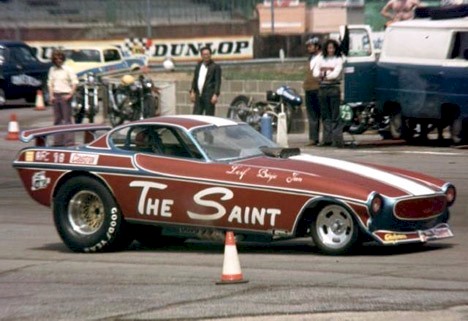
The Volvo P1800 Funny
Car of Leif Dabach, Janne Carlsson and Borje Holmgren began life in 1973
as a stock steel bodied altered running a Chevy 327 on carbs. By 1974 it
was a fully fledged flopper with fiberglass body, home built chassis and
454 nitro burning Chevy. It appeared in England at Silverstone racetrack
in June 1974 along with fellow Swede Bjorn Andersson and England’s
Dennis Priddle in his STP Avenger. Lack of traction kept the cars in the
eights but Priddle found enough grip to claim the first of many English
Swedish Funny Car encounters. (Photo by Alan Currans; text by Andy
Barrack)
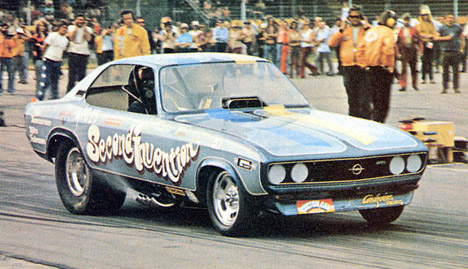
When Bjorn Andersson
and Tage Hammerman appeared with their “Second Invention” Funny Car in
1973, they were already veterans of Swedish drag racing. As early as 1967,
without a drag race yet staged in Sweden, Bjorn and Tage began building
the country’s first double A fuel dragster. Two years later “Sub
Sonic” was debuted at Anderstorp, the initial venue for Swedish drag
racing. Bjorn Andersson was the driver. Then in 1972 the duo started work
on what would be Sweden’s first nitro Funny Car.
Based on a ’73 Opel
Manta, the appropriately named “Second Invention” had a 108 inch home
built chassis, with a 392 hemi with 3/8 stroker crank = 398 cu in, Engle
roller camshaft, Summer Brothers camshaft drive, Donovan valve gear,
Enderle injection, Howard connecting rods, M/T pistons with Dykes top ring
and 7,25:1 kompr. Bowers 6-71 blower 22 % overdrive and Crowerglide 3 disc
clutch, with Lenco 2 speed. The body was lengthened about 12 inches and
the roof was lowered about 2 inches in front.
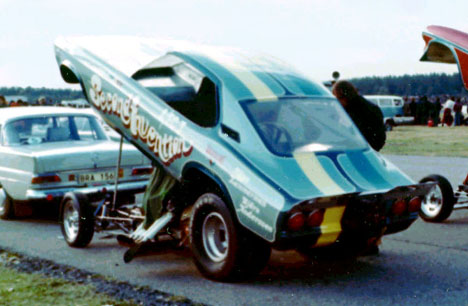
The car’s first
appearance outside of Sweden was at Silverstone, England in 1973. The
team’s final round victory against the Fuel Altered of Fred Whittle
would have made Bjorn Andersson the first AA/FC Champion in Europe if it
wasn’t for the fact that Bjorn had to race in the Top Competition
Altered eliminator (England’s equivalent of AA/FA), as no Funny Car
class then existed in Europe. As well as repainting and renaming “Second
Invention,” Bjorn Andersson and Tage Hammerman also dropped the Hemi in
favor of a 454 Chevy when “Manta Ray” reappeared in 1975. Bjorn
Andersson co-owned one of Sweden’s leading speed shops, Leufvens Racing
Services AB of Stockholm, and the switch in powerplants was because “we
had more experience with Chevrolets as we had been building Chevy engines
for race cars and race boats for several years,” recalls Tage.
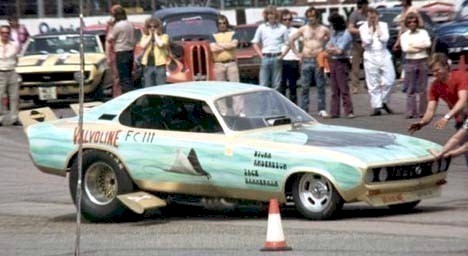
“Manta Ray” was
one of seven AA/FC’s that appeared at Wroughton, Wiltshire in England in
June 1975 – the largest gathering of Funny Cars then seen in Europe.
ET’s at the event were in the low 7’s as the Wroughton airbase offered
little traction. Bjorn and Tage later sold “Manta Ray” to Janne
Carlsson and Morgan Aronsson, to finance their next AA/FC project. (Photo
courtesy of Alan Currans; info from Andy Barrack)
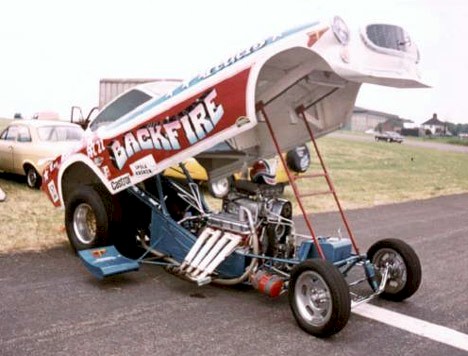
Jan Carlsson, Borje
Holmgren, and Leif Dabach changed the name from “The Saint” to
“Backfire” when they gained sponsorship from Peders, a leading
importer of American cars. In its new paint scheme the Volvo was one
of seven Funny Cars racing at Wroughton, Wiltshire in June 1975 for the
Tor Line Funny Car Championship – the first international drag racing
series staged between England and the Scandinavian countries.
“Backfire” remained Chevy powered and stayed a 7 second runner at best
but was destroyed later in '75 in a crash at Mantorp Park, Sweden. Dabach
was severely injured when the car barrel-rolled but fortunately
recovered. This was the end of the road for the team who then split up.
(Photo & info courtesy of Alan Currans and
www.theaccelerationarchieve.co.uk; additional info courtesy of Andy
Barrack)
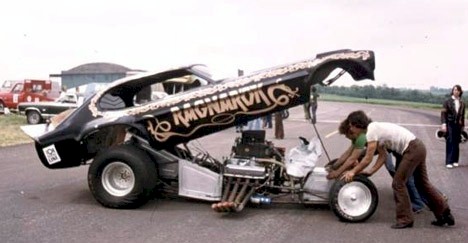
Swedish racer Hans
“Hazze” Fromm built his first AA/FC in 1975. The “Ragnarok” Capri
was preceded by an A/FC Capri that had been raced in 1972 through 1974 by
Fromm. The name “Ragnarok” comes from the place in Norse mythology
where Viking warriors go in the afterlife. Fromm ran an advertising
business in Stockholm and built his own cars. British magazine Custom Car
described his large 520 cubic inch Chrysler Hemi as “Garlits Prepared”
and when Hazze found the engine too powerful for some of the European
tracks he placed a cigarette packet under the throttle to slow things
down! The car was a low seven-second contender. (Photo courtesy of Alan
Currans, text by Andy Barrack and Pelle Lindelov)
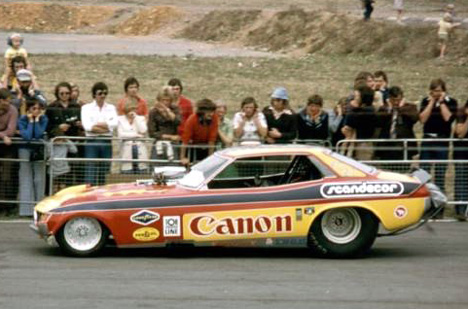
The first Toyota
funny car was the Canon Celica raced by Roland Larsson and Ake Ryman. The
Larsson and Ryman team had debuted an A/FC in 1972 but had progressed to
the Celica AA/FC by the following year. The car was all home-built, from
the 114 inch chassis through to the bodywork - with Toyota providing
financial backing for the body to be made. A 427 cast iron Chevrolet
provided the power using about 50% nitro. The car with Ake Ryman driving
ran sevens at best while racing at tracks like Mantorp Park, Snetterton,
Santa Pod and other Europe racetracks. (Photo by Alan Currans; info from
Draglist files)
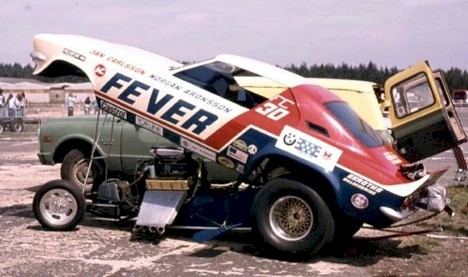
After
the end of “Backfire,” Jan Carlsson teamed up with Morgan “Mogge”
Aronsson and purchased Bjorn Andersson’s original Opel Manta. Carlsson
who had entered his 1960 T-bird at Sweden’s first ever drag race in
1968, took on the driving chores. The Opel was renamed “Fever” but
stayed with the big block Chevrolet for power. After having achieved a
personal best of 7.5 Carlsson then suffered serious burn injuries when
“Fever” fireballed just before the lights at Mantorp Park in August
1976. With burns to his arms, legs and back, and his eyesight giving
doctors grave concern, Janne spent nearly a year in hospital but
eventually recovered. Although he never drove again, he was back in 1980
with Morgan Aronsson and “Stigge Hansson” fielding a new Camaro bodied
flopper. (Photo by Alan Currans; text by Andy Barrack)
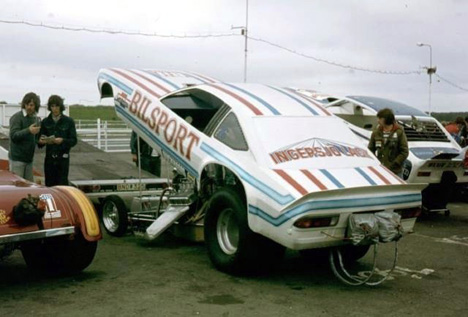
Although sharing the
same name, the same aspirations to go drag racing AND living in the same
village, Bjorn Andersson and John Andersson were not related and did not
know each other existed until Tage Hammerman and Bjorn Andersson
discovered John Andersson and his brother Ollie, along with Bosse
Carlsson, were building their own front-engined AA/FD dragster just a mile
from the “Sub Sonic” workshop. This amazing coincidence meant that the
first two fuelers in Swedish history - “Sub Sonic” and “Valkyrian”
- emanated from the same tiny spot on the map, yet in complete isolation
from each other. But such close proximity created a natural affinity and
from 1968 to 1975 the two teams went from slingshots to funny cars and
became the most prominent figures in Swedish drag racing.
Then in 1976 the
teams merged as Bjorn Andersson retired from driving to concentrate as
crew-chief (“The car had become very fast by then..” says Tage) and
John Andersson took his seat. The Funny Car that resulted from this merger
was a new style Opel Manta with an imported Jungle Jim chassis. An
aluminum Rodeck (Block #17 to be precise) replaced the Chevy 454 and with
this combo John Andersson became the first Swede into the sixes in 1976
(6.92/209 mph at Santa Pod Raceway). Later the team picked up sponsorship
from “Bilsport,” Sweden’s leading motorsports magazine. In 1979 the
car became the “Blue Swede” BB/FC of Tommy Svensson while Bjorn and
John went on to field a Chevrolet Monza AA/FC. (Photo by Alan Currans;
Text by Tage Hammerman and Andy Barrack)
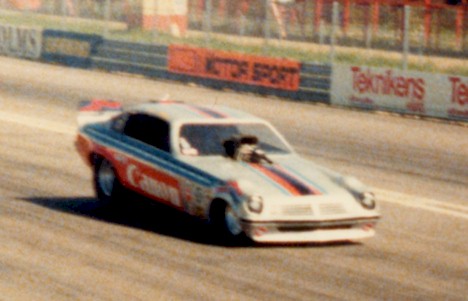
Leif Dabach returned
to driving funny cars after crashing the “Backfire” Volvo. In 1977 he
appeared in the seat of Ryman & Larsson’s “Canon” Vega. Ryman
and Larsson again built the car themselves. The car began with Chevy power
but a Hemi was later used along with the eight port Crower injector. The
silver Vega ran low sevens. (Photo courtesy of Lars Pettersson; text by
Danny White)
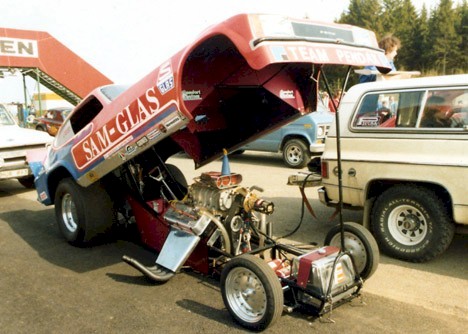
Peter Andersson (no
relation to Bjorn or “Johnne” Andersson) purchased Liam Churchill’s
“Euro Sting” Capri around 1978. With fellow Swede Stig Hansson
destined for driving duties, the car saw little action before Peter
Andersson sold the “Sam Glas” Capri onto Janne Carlsson and Morgan
Aronsson. They in turn sold the chassis onto a Danish BB/FC team, electing
to build a new Funny Car instead. Liam Churchill at least had the
distinction of being the first European FC driver to put a iron 392
flopper into the sixes a couple of years earlier, the Irishman benefiting
from the tuning skills of Geof Hauser, one time crew chief for Clive
Skilton and today successful owner of Hauser Racing Cars. (Photo courtesy
of Pelle Lindelov; info courtesy of Janne Carlsson; text by Andy Barrack)
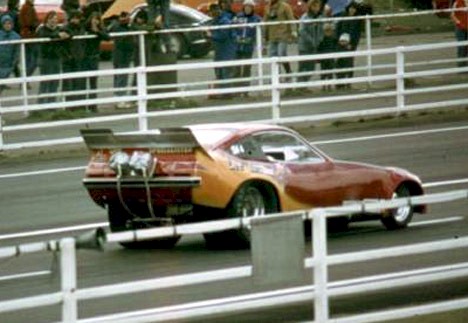
Lee Anders
Hasselstrom began AA/FC racing in 1977 with the “Denim Machine” Monza.
Lee Anders Hasselstrom was one of Europe’s most financed funny cars in
the 1970s. His funny cars were frequently updated with new paint designs
and Hasselstrom regularly purchased new and used parts from the USA.
Hasselstrom employed the best crew Sweden could provide and carried the
Monza around in an American built fifth wheel trailer. In 1978 he gained
lucrative sponsorship from Flygvapnet - the Swedish Air Force. In the same
year, using a Milodon engine, he became the quickest and fastest funny in
Europe with times of 6.55 219 on different passes. In 1979 Hasselstrom
recorded a 6.48 clocking at Santa Pod. That year at the World Finals he
received a 6.19, 210 M.P.H. time slip. (Alan Currans photo courtesy of www.theaccelerationarchive.co.uk;
info from Andy Barrack)
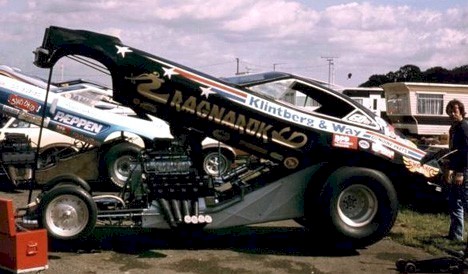
Hazze Fromm replaced
the “Ragnarok” Capri with a new Mustang II. Featuring sponsorship by
American auto parts suppliers, Kleintberg & Way, the Mustang II was
powered by aluminum Keith Black Hemi replacing the cast iron Hemi of the
previous Capri. The car broke in the high-sixes with a known best of 6.78.
Fromm sold his funny car operation in 1983, the engine going into Pelle Lindelov’s
Top Fueler and the chassis becoming Mats Westman’s BB/FC. Lindelov
recalls working with Fromm did have its problems, “When you asked Hazze
for an 8 millimeter spanner, he’d reply “Why can’t you ask for a
real tool, like ¼ inch or ½ inch?” When we asked why he didn’t use
metric sizes like the rest of us Swedes, Hazze always said, “Who won the
war? The millimeter guys or the inch guys?” End of discussion!” (Photo
courtesy of Alan Currans; info provided by Pelle Lindelov, Andy Barrack,
and Draglist files; text by Andy Barrack and Danny White)
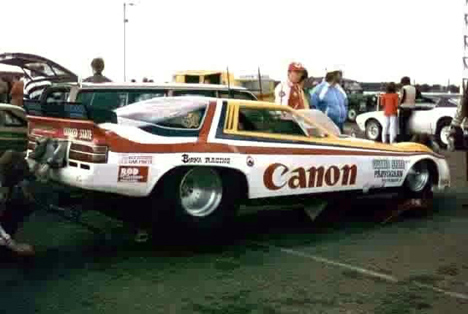
Ryman & Larsson
built the last “Canon” funny car in 1979. They built the car as usual.
The Canon Challenger was the team most competitive entry ever. Leif Dabach
was the car’s pilot running 6.60’s best times with the car. The team
used the ½” stroke Keith Black Hemi for power unlike the Chevy and the
Donavan used in the past. This allowed the team to step up with the best
of Europe’s funny car racers. Ryman, Larsson and Dabach raced into the
early eighties with the car until the team retired. (Photo courtesy of
Alan Currans; text by Danny White)
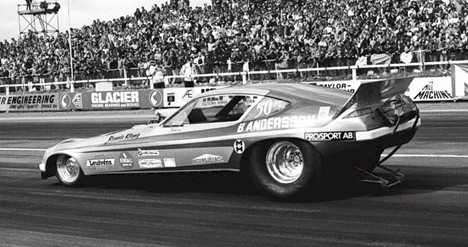
Bjorn Andersson
imported the Iverson & Kimble Monza from United States (see Round 29)
and retouched the basic paint to cover the previous team’s lettering.
With John Andersson driving the car made its first appearance at Mantorp
Park in July 1978 and reached the final only to lose to rising Swedish
star “Lee” Anders Hasselstrom. The Andersson’s Monza used a 482 cu
in Keith Black engine and got down as low as 6.38 by the end of the
decade. Bjorn Andersson later became crew chief for Hasselstrom. Today
Bjorn works for Pennzoil and is no longer involved with drag racing.
(Photo from Peter Jones; Text by Andy Barrack)
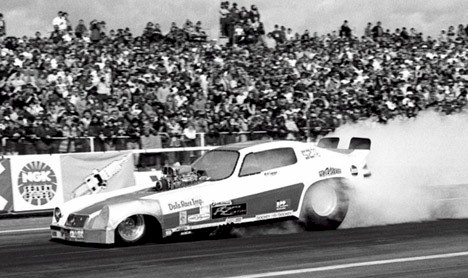
Having sold the
“Sam Glas” Capri, Janne Carlsson and partner Morgan Aronsson decided
to build themselves a brand new Funny Car chassis based upon Bjorn
Andersson’s imported Monza (“Rigid chassis with no suspension was the
new thinking, and if that was good enough for the Americans, it was good
enough for us. So we copied Bjorn’s state-of-the-art Monza,” remembers
Janne.) The Donovan engine was purchased from “Lee” Anders
Hasselstrom, stroked out to 480 cu in with cast iron heads, Venolia
pistons and an Engle cam. A Lenco 2 speed put the power to a 4:10 rear
end.
The Camaro body came
from Bo Bertilsson who had used it on his “Berzerk” BB/FC. With Janne
still receiving medical treatment for his burn injuries Stig Hansson was
given driving duties. When the Camaro FC eventually disbanded in the early
80s, Janne Carlsson became crew chief for the Swedish P&G Racing Top
Fueler and remained in the team until driver Pelle Lindelov’s retirement
in 2001. (Peter Jones photo; info from Andy Barrack and Janne Carlsson)
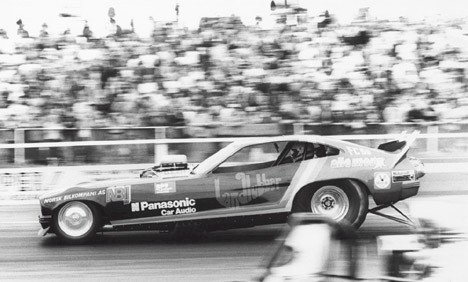
These days Rune Fjeld
is known as one of Europe's top crew chiefs and has been described by none
other than Carl Olson and Gordie Bonin as "the Austin Coil of
Europe”. The Norwegian first made a name for himself owning and driving
BB/FC's before switching to nitro. With the ex Shirl Greer Mustang II he
made his debut at Mantorp, Sweden in May 1979 with immediate success.
A new paint job and
Panasonic and Landlubber backing came in the following year. Fjeld set
tongues wagging with a 239 mph run at the Santa Pod World Finals in
September 1980. Fjeld continued racing with a variety of newer and quicker
FC's through out the 80s before hanging up his helmet and concentrating on
owning and tuning Top Fuelers. Rune Fjeld has put such drivers as Liv
Berstadt, Rico Anthes, Barry Sheavills, Andy Carter and Gordie Bonin into
the record books and given them European Championship titles. Fjeld is
also responsible for England's first 4 and first 300 mph runs and remains
one of Europe's most revered engine tuners. (Photo courtesy of Peter
Jones, text by Andy Barrack)
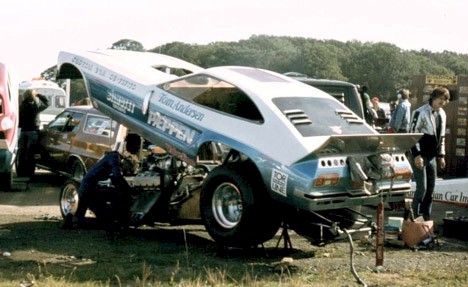
Norwegian funny car
racer Tom Andersen has a name that sounds the same as American funny car
racer Tom Anderson. But note the difference in the spelling of the last
name. Before switching to funny cars Tom Andersen had driven the “Van
Iderstine” AA/FD that was exported to Norway around 1975 and renamed
“Black Magic” when it was raced in European Pro Comp. In 1979 Andersen
then purchased this Mustang II funny car from fellow Norseman Steinar
Stolen. The car was another US import originating from Carmel, NY, where
it was built and driven by Drake Viscome under the name “Vindicator.”
Steinar Stolen campaigned the Mustang II in Pro Comp – although he also
ran it in Funny Car at Santa Pod’s 1977 World Finals – before selling
it, to make way for his next acquisition - the “California Charger” of
Keeling and Clayton (which Steinar Stolen also ran as a BB/FC).
Andersen purchased
the Mustang II from Stolen but preferred to run nitro and with sponsorship
from Sko Uno he renamed the car Paeppen (a Norwegian play on words meaning
‘pep’ as in ‘pep talk’) and raced the flopper from 1979 and into
the early 80s. Unfortunately Andersen was often left outside the pack of
other Scandinavians as a DNQ and retired from racing after his brief foray
in Funny Car. (Alan Currans photo courtesy of www.theacceleartionarchive.co.uk;
info from Bjorn Vidar Pedersen and Andy Barrack)
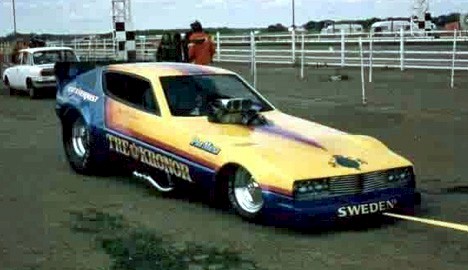
Harlan Thompson left
the United States drag racing scene in 1980 to race in Europe. Thompson
had raced his funny cars, the “Fireball Vega,” the “Fireball
Monza,” the “Tom ’n’ Jerry” Mustang, and “Saturday Night
Fever” Starfire. The “Tre Kronor” job came by chance. Knut
Soderqvist and Thompson frequented the same NY speed shop. Soderqvist
offered the driving job on his newly acquired top fueler to Thompson.
Thompson declined the job, but he told Soderqvist if he bought a funny car
he would be interested. Knut Soderqvist bought Ed McCulloch’s former
Arrow from Roy Wickard for $6,500.
Soderqvist and
Thompson took the car to Maple Grove and ran a 6.43. The team also ran at
Lebanon Valley. The call went out to Roy Phelps, then owner of England's
Santa Pod Raceway, that Soderqvist had a six-second funny car to book.
Soderqvist moved back home to Sweden with Thompson and the “Tre
Kronor” Arrow. The Soderqvist and Thompson team made its European debut
at Santa Pod in July 1980 and won the World Finals against Gene Snow a
couple of months later. The pair became the dominant funny car team in
Europe for the next 15 years until the duo split. (Photo courtesy of Alan
Currans; info and text from Danny White and Andy Barrack)
[ Back ] [ Home ] [ Next ]
|
